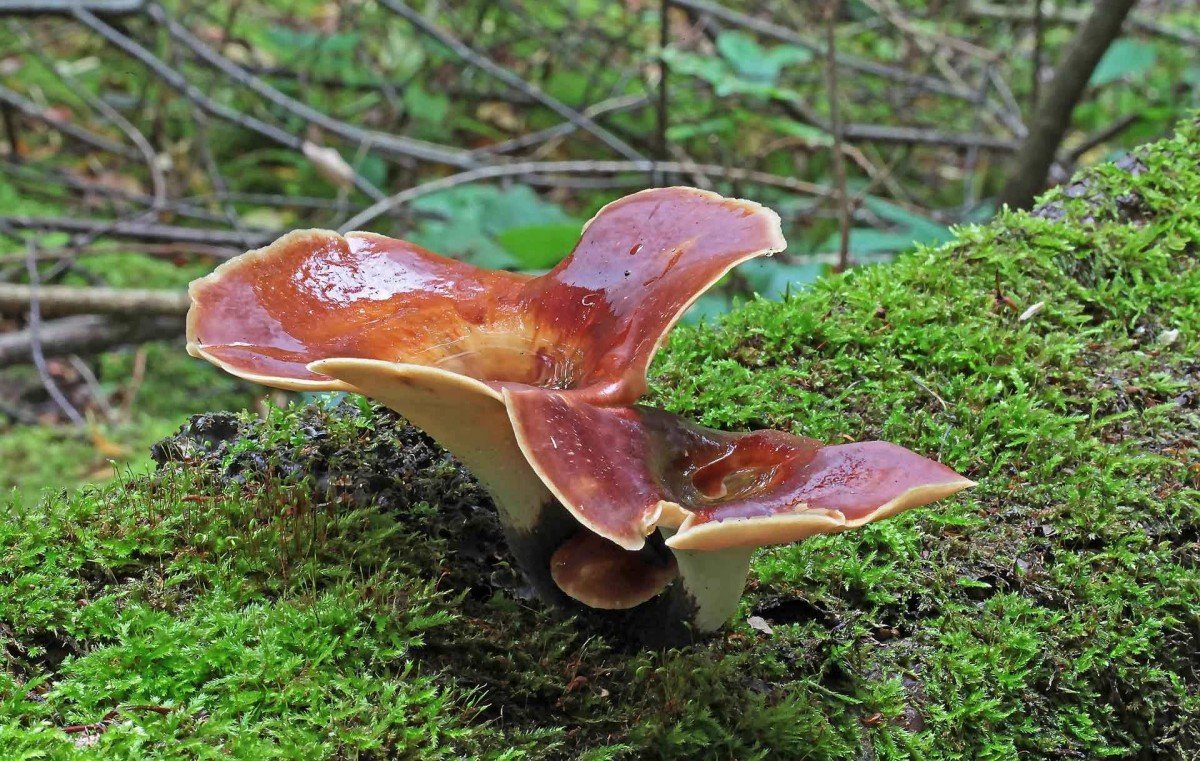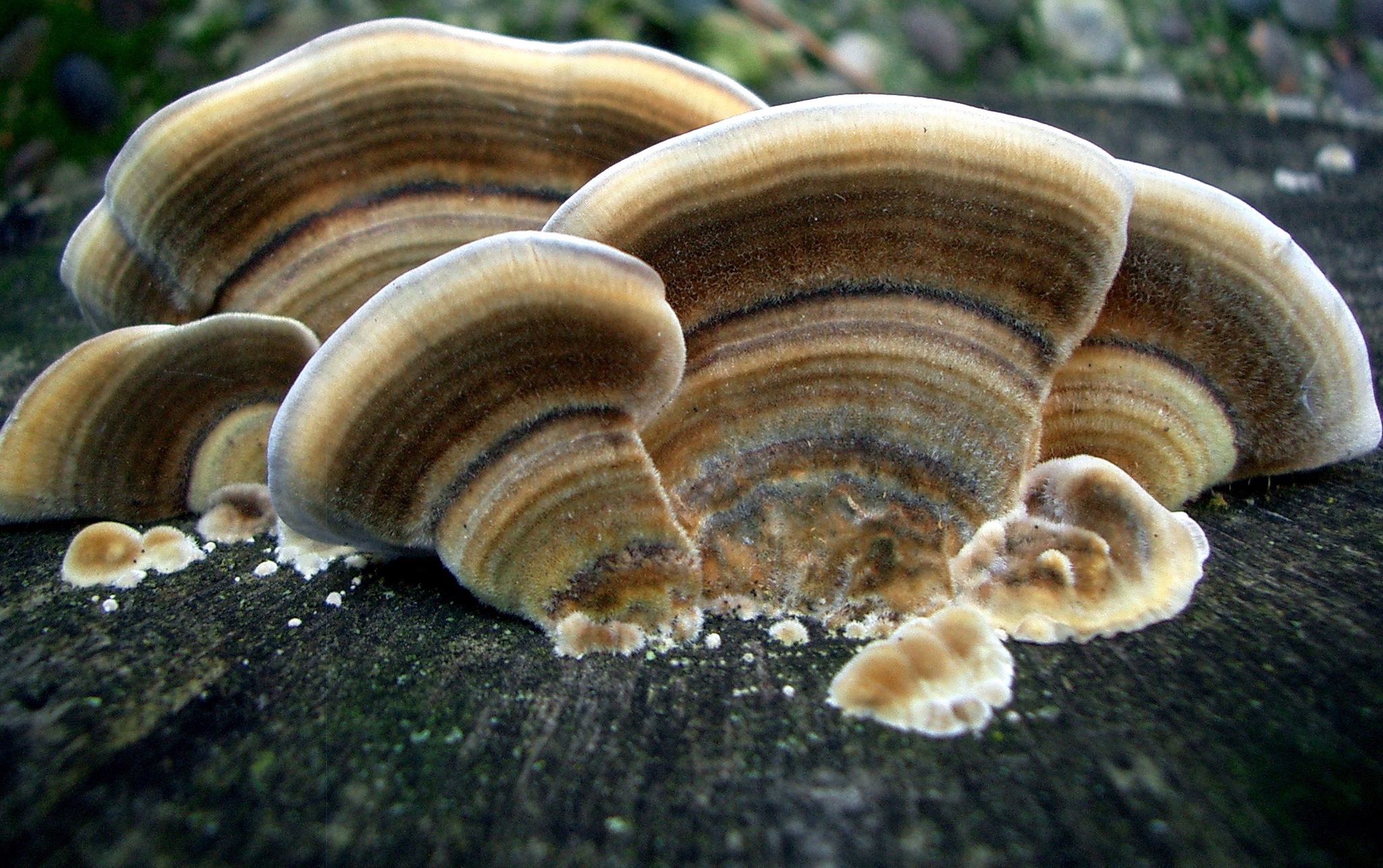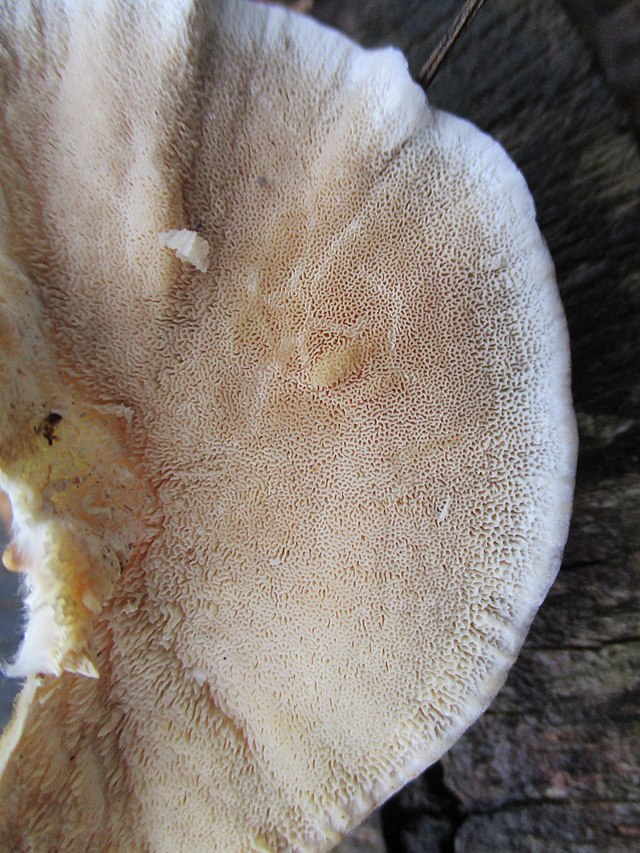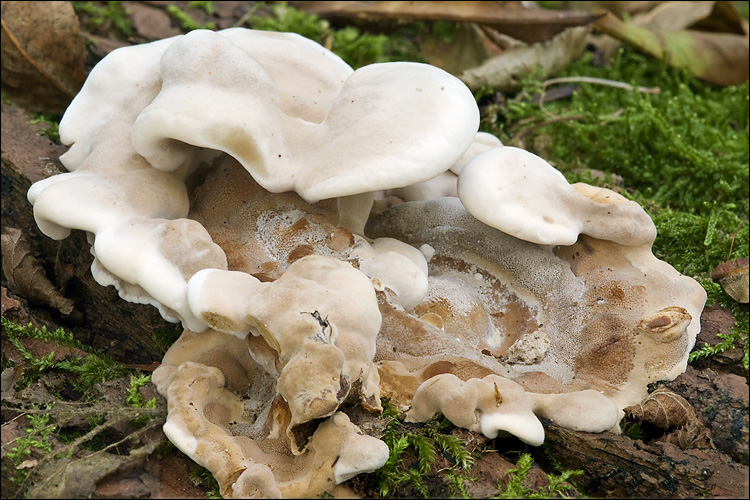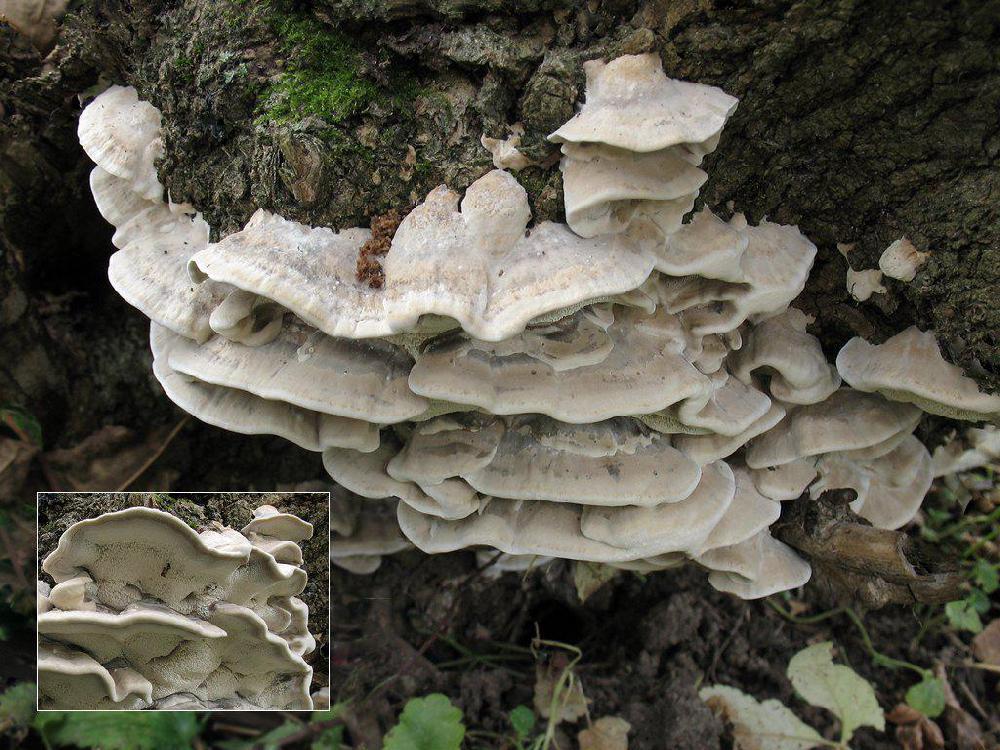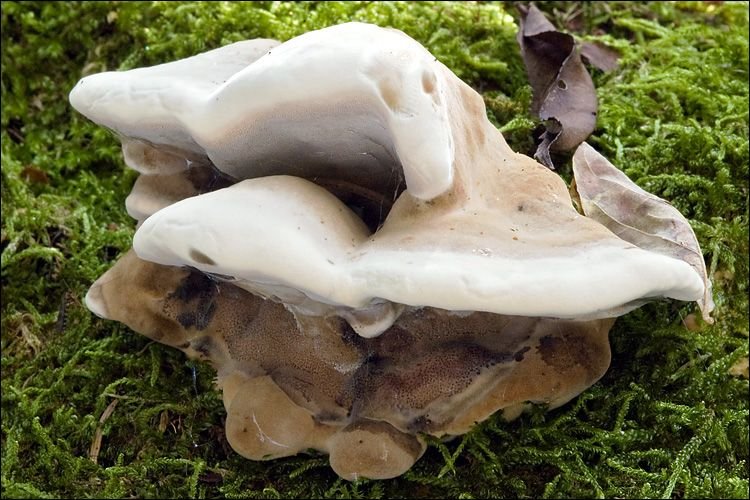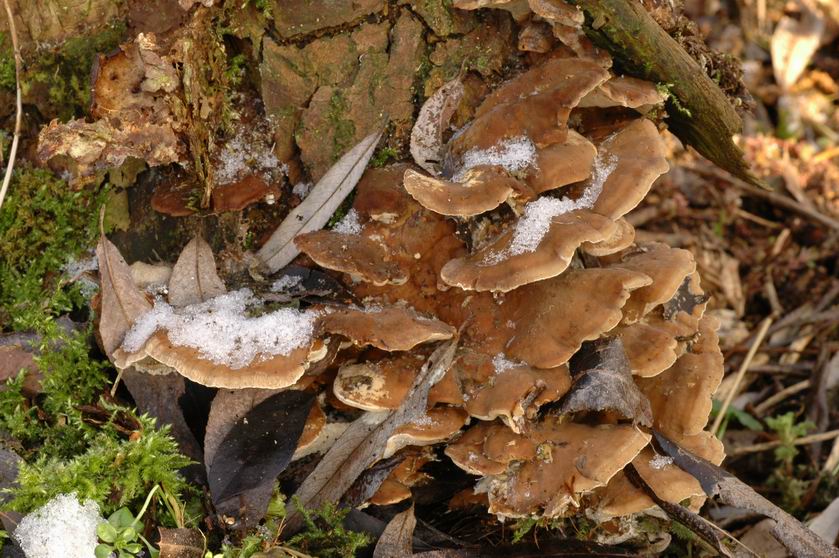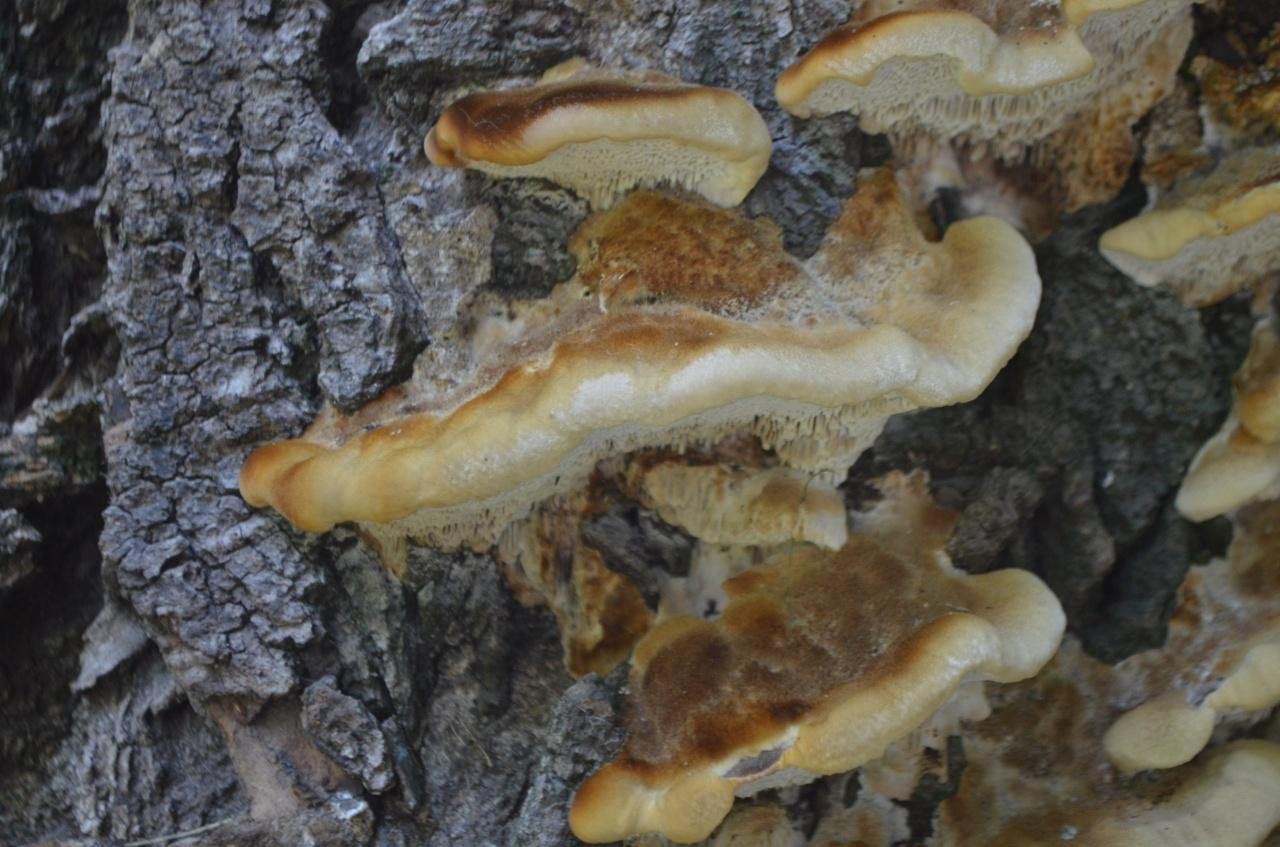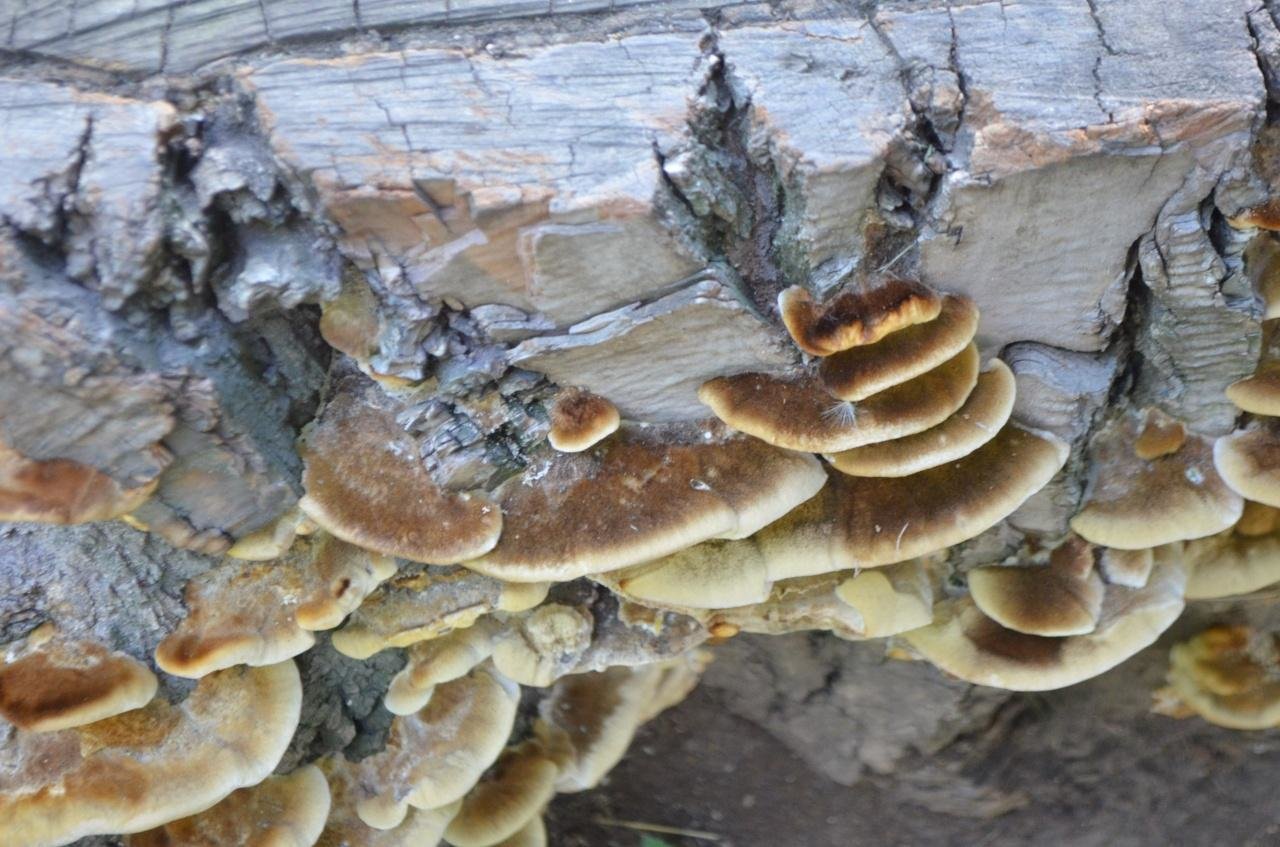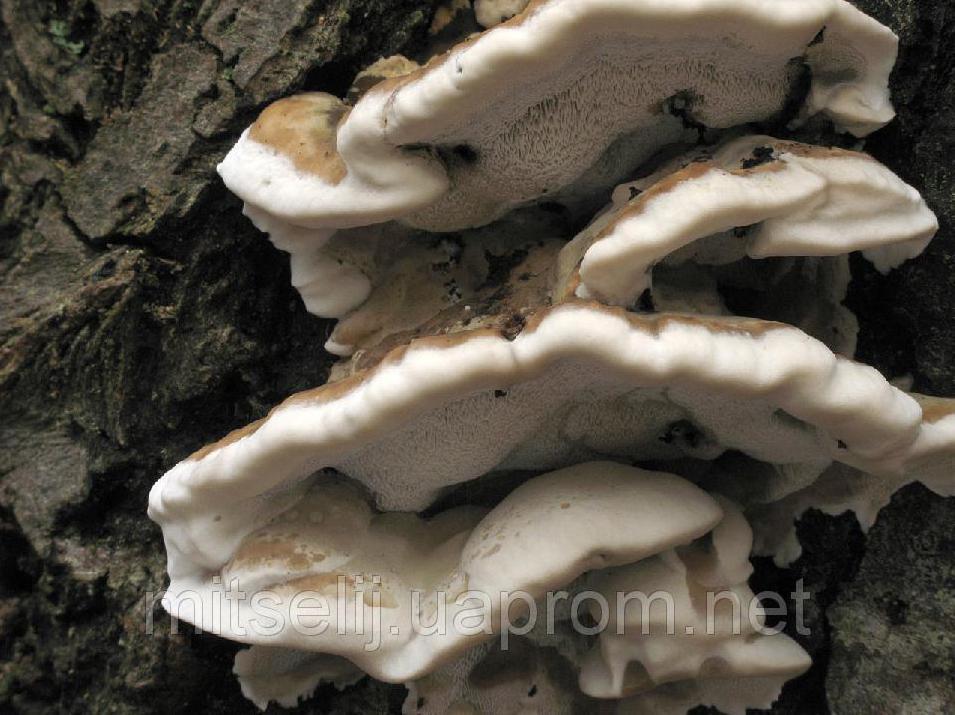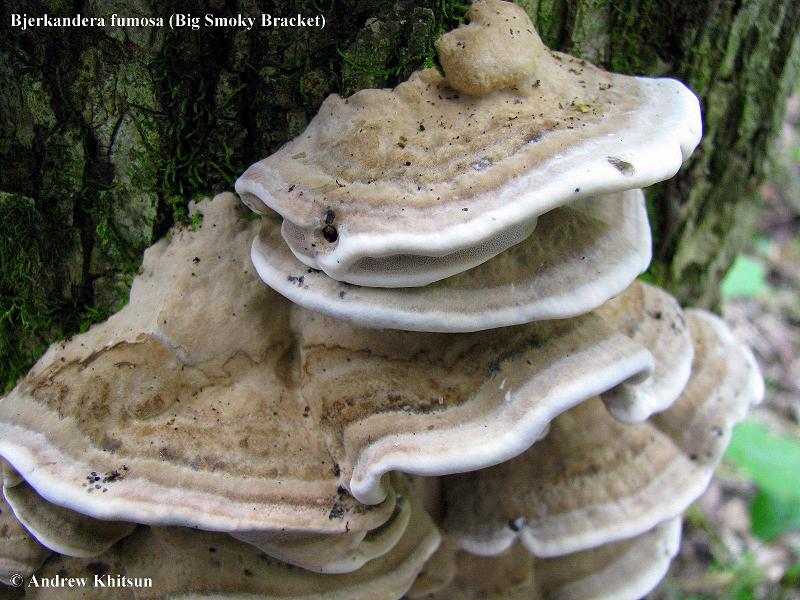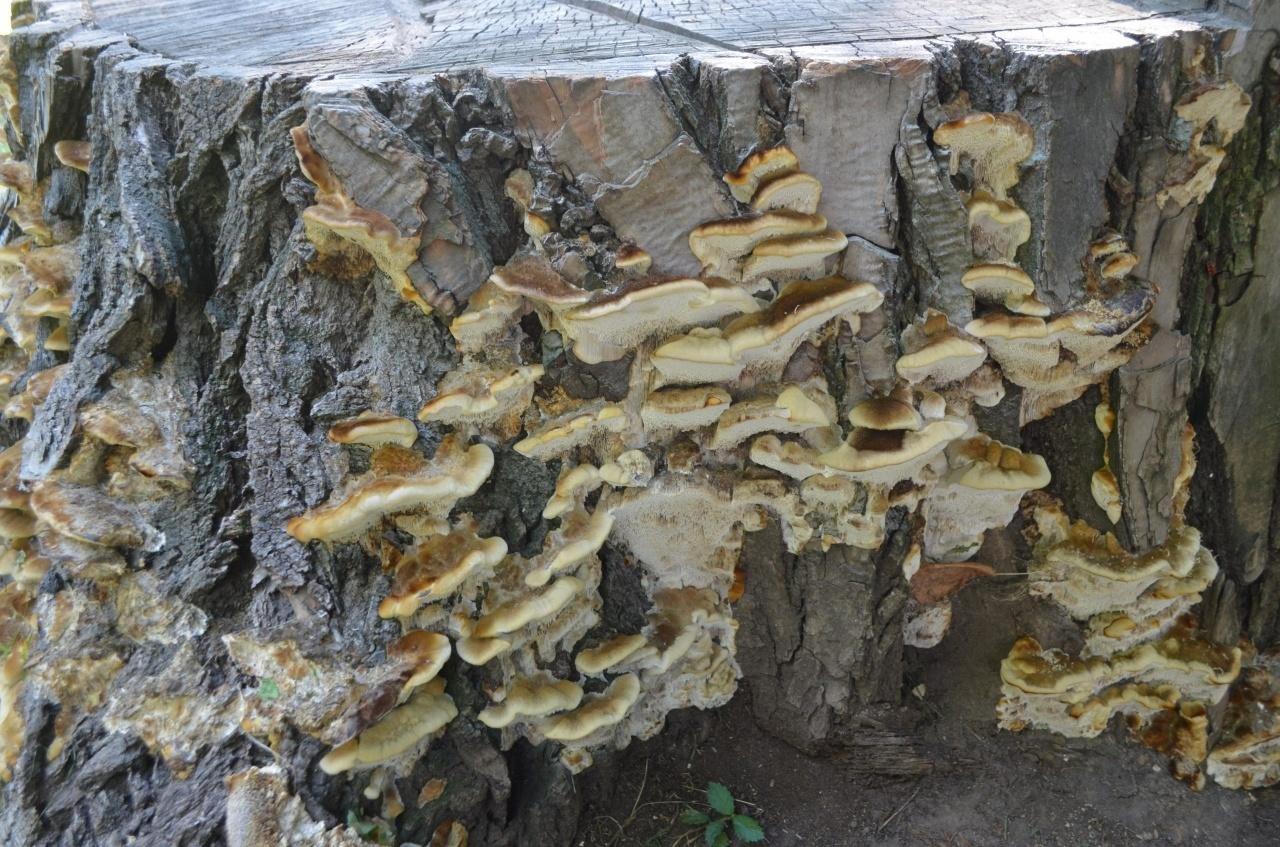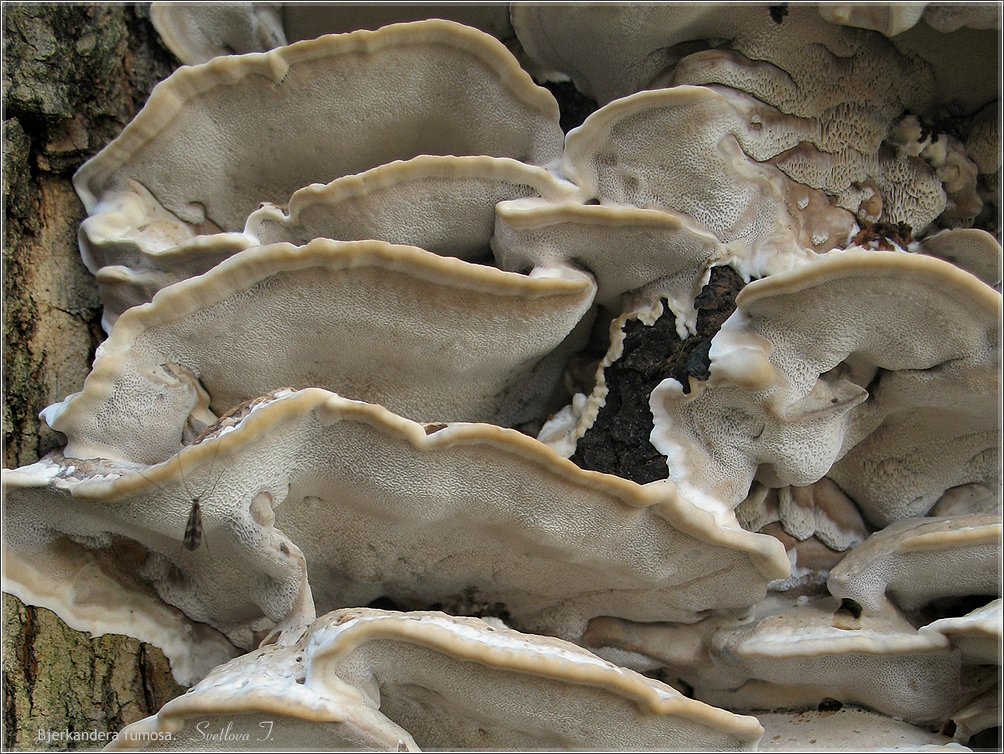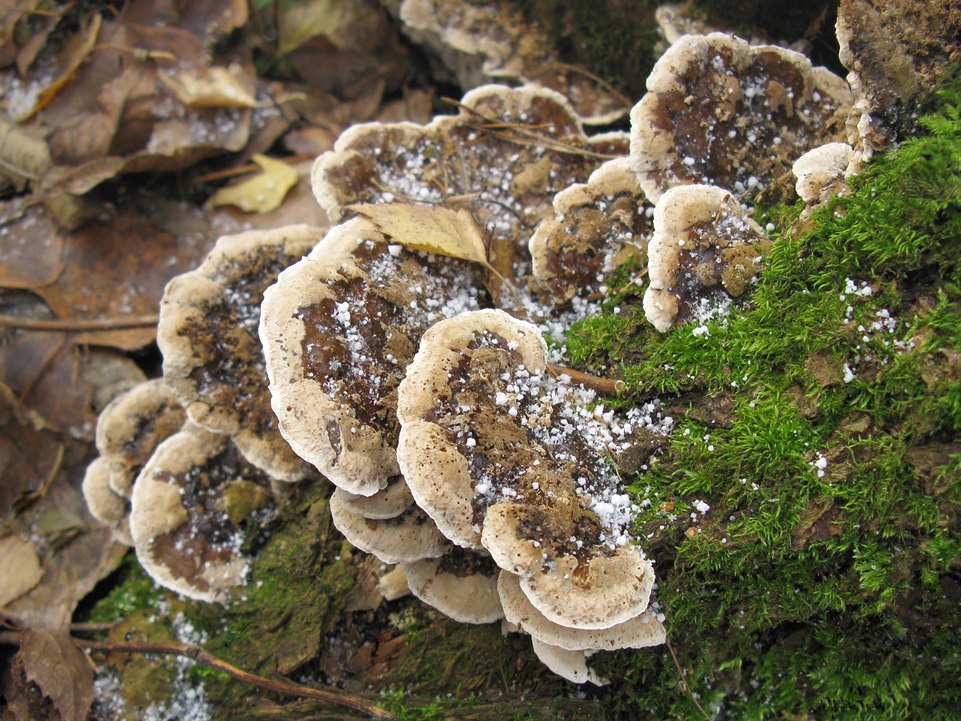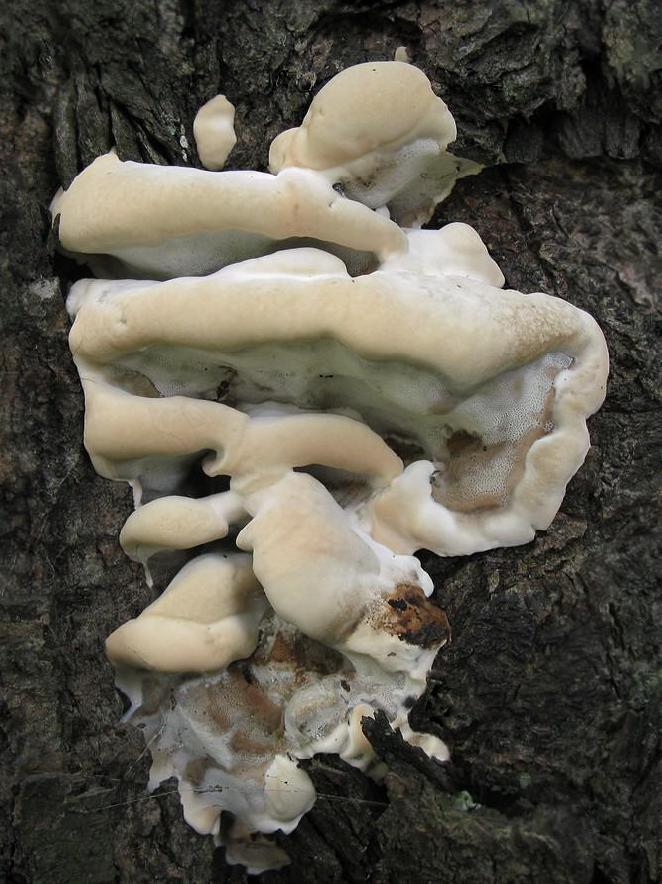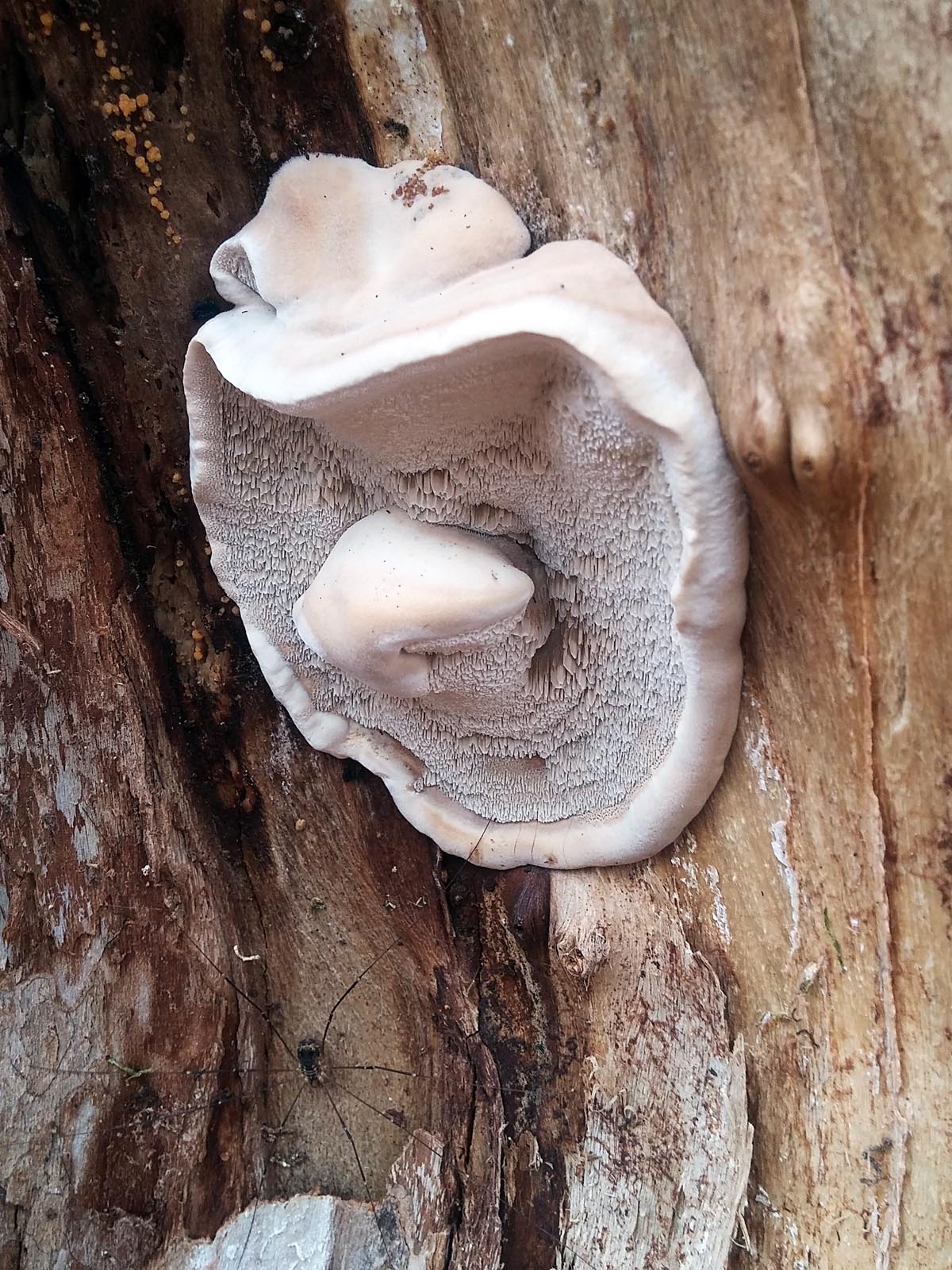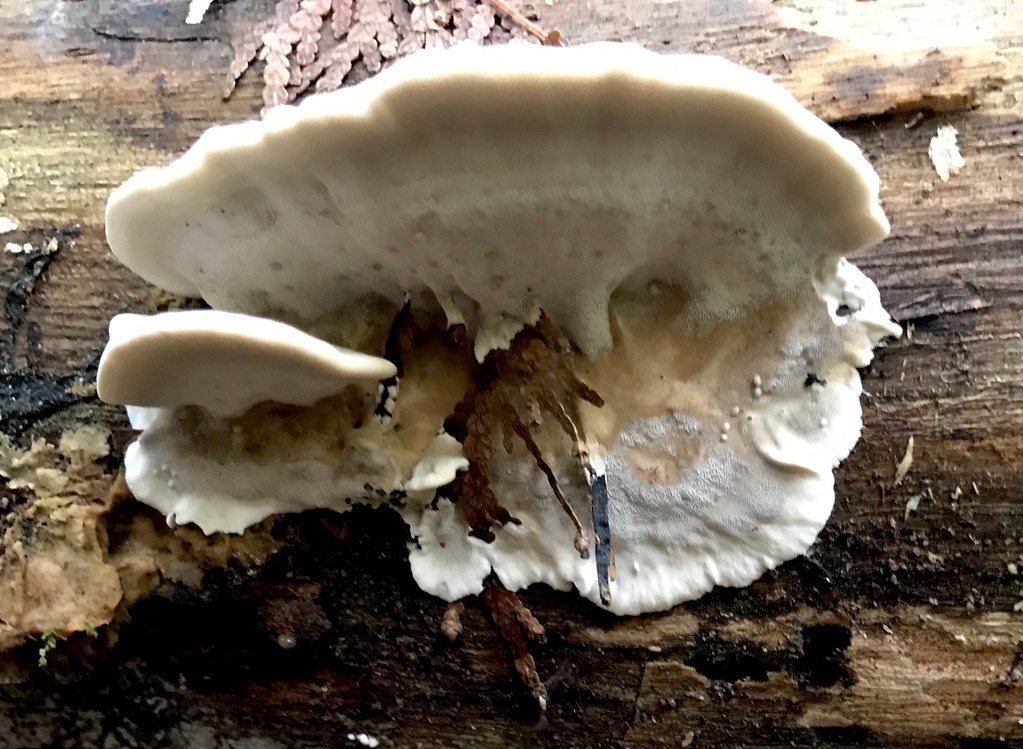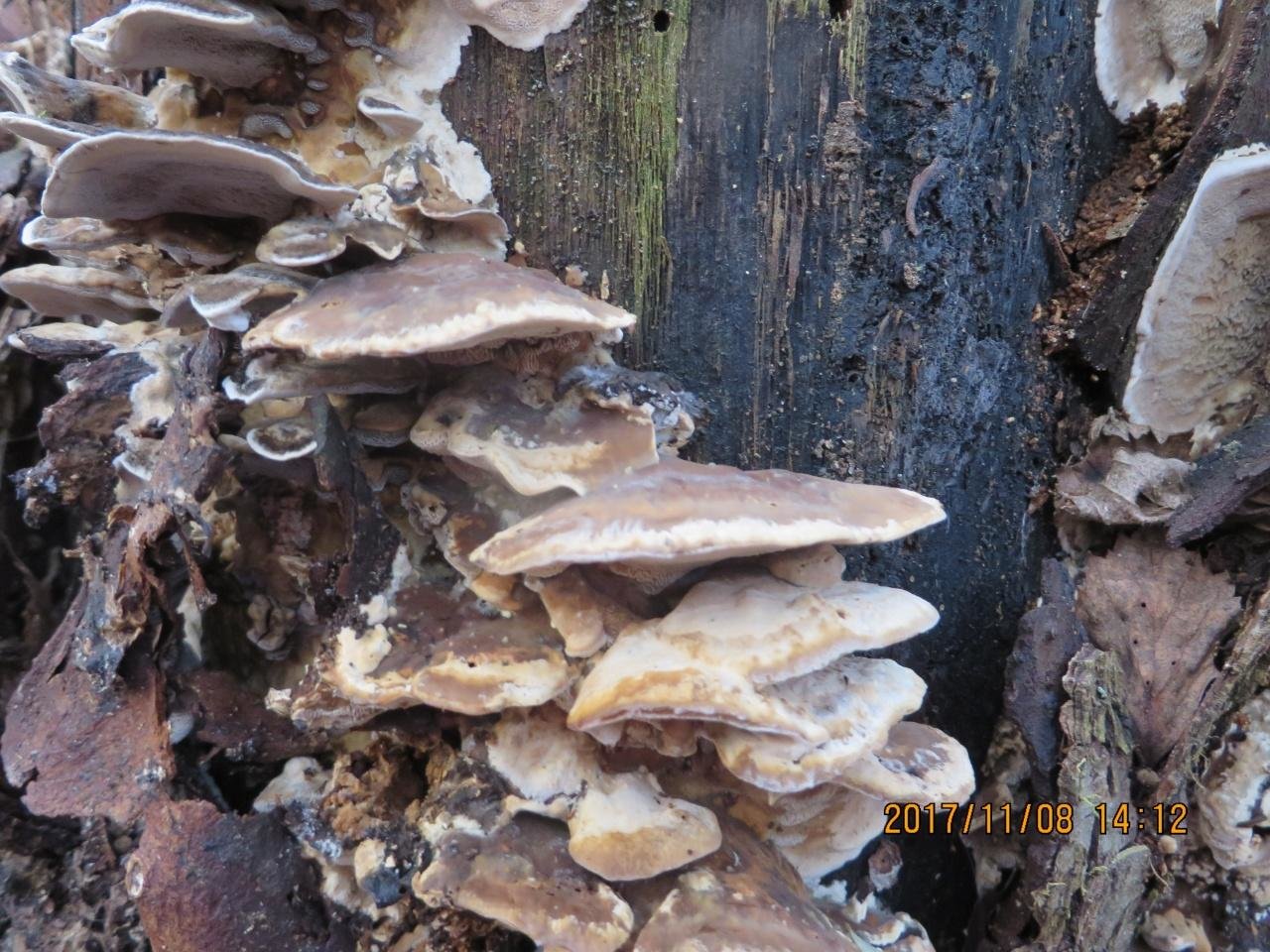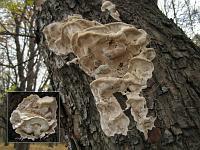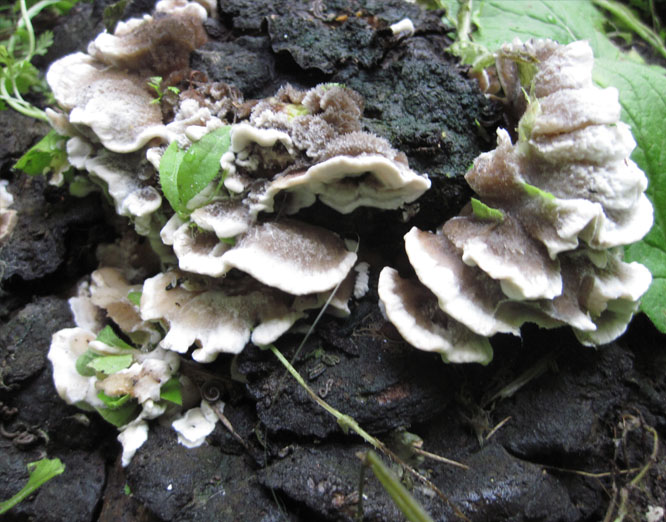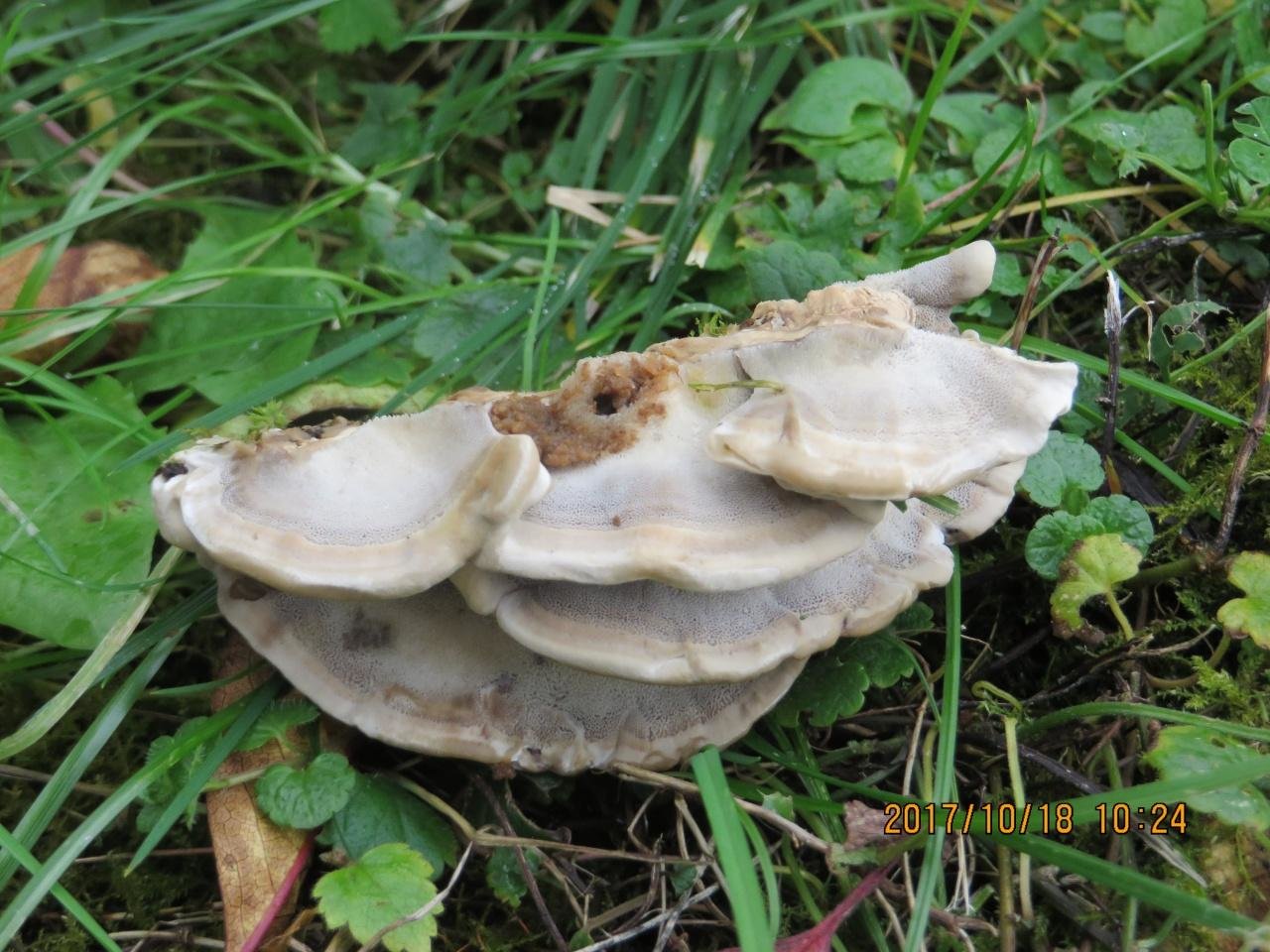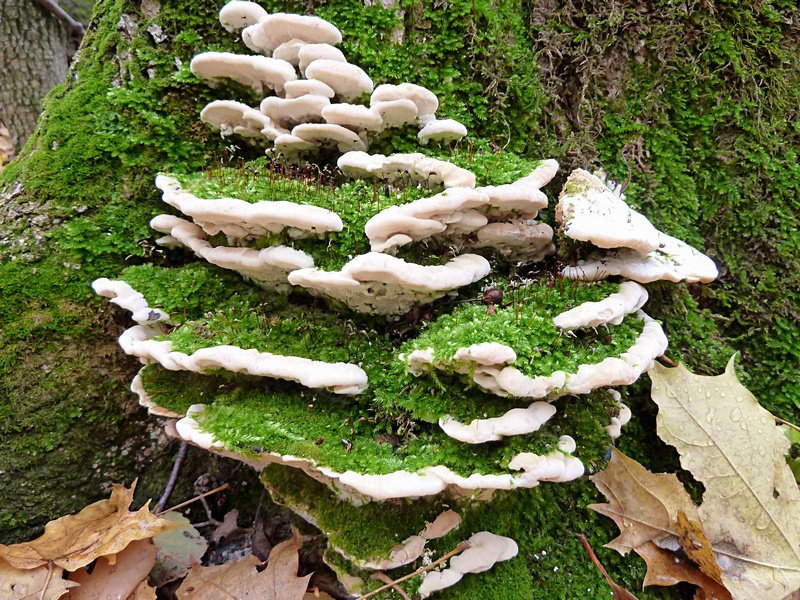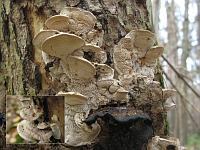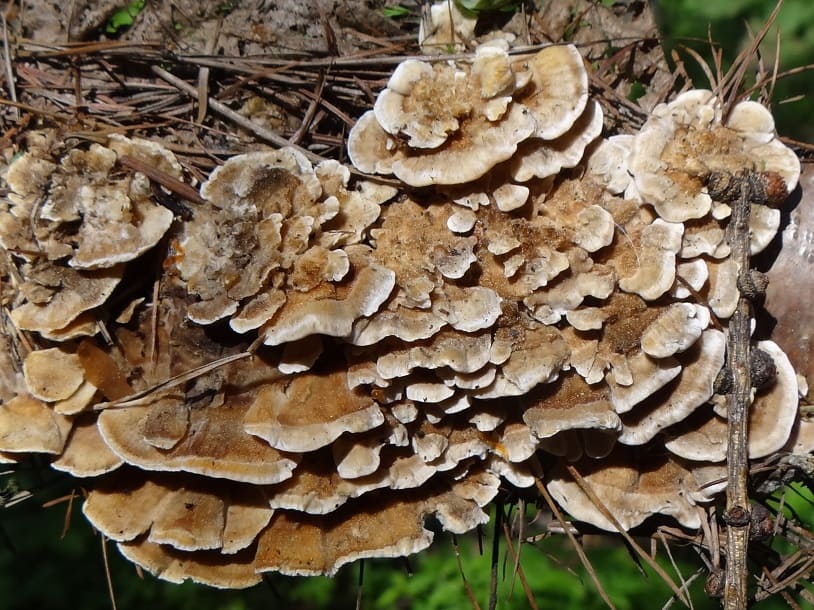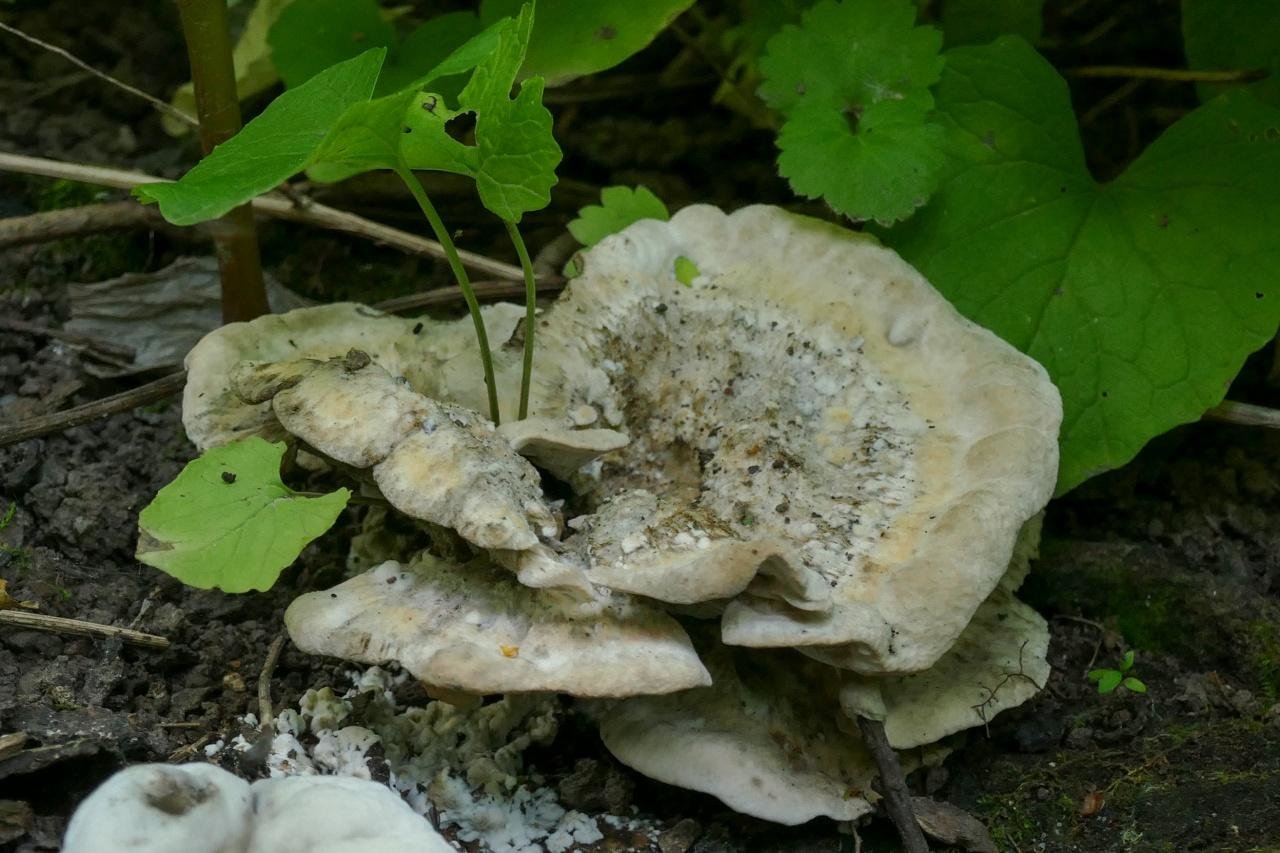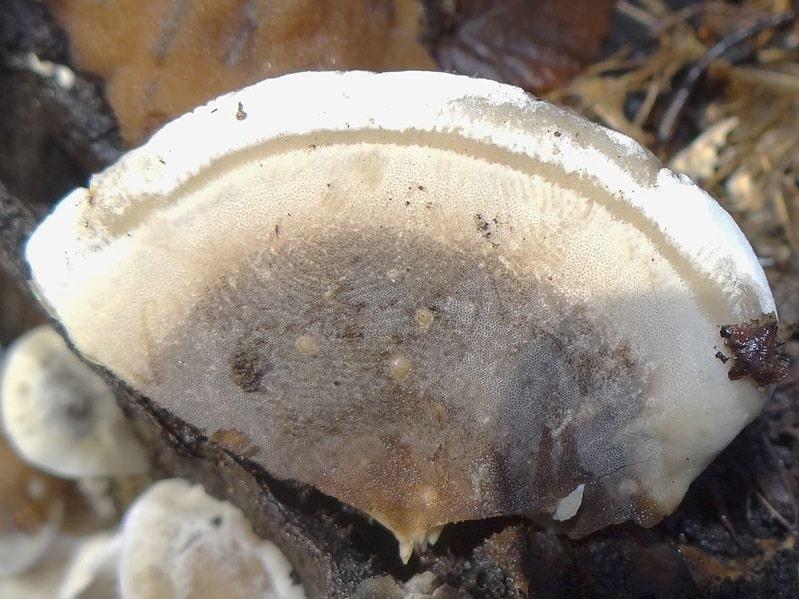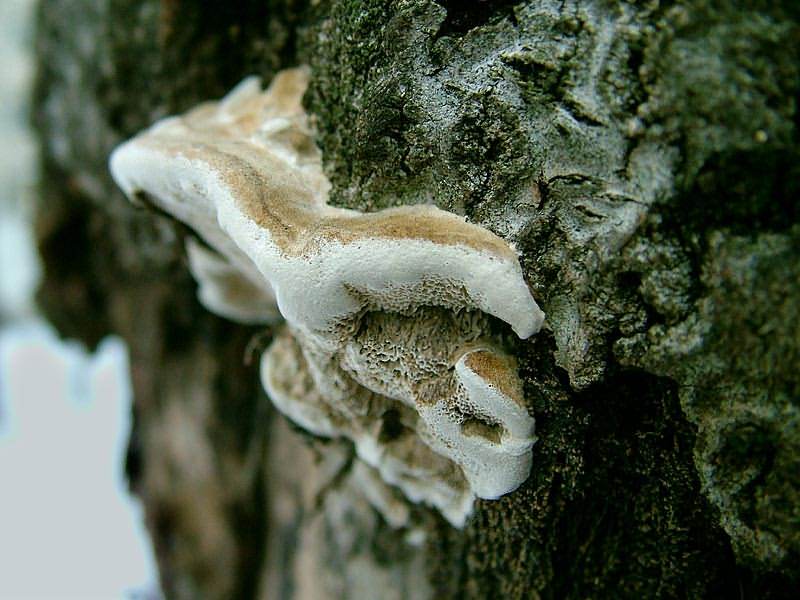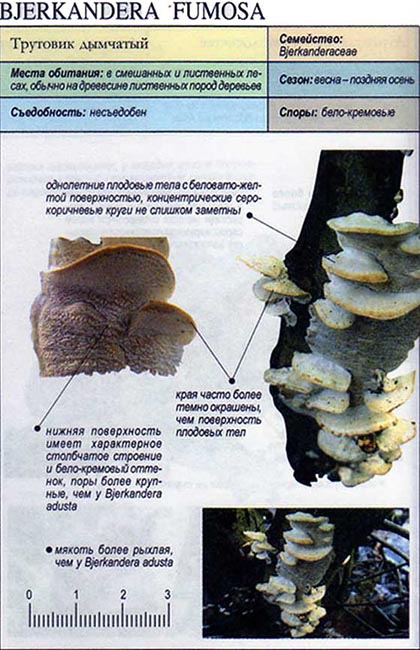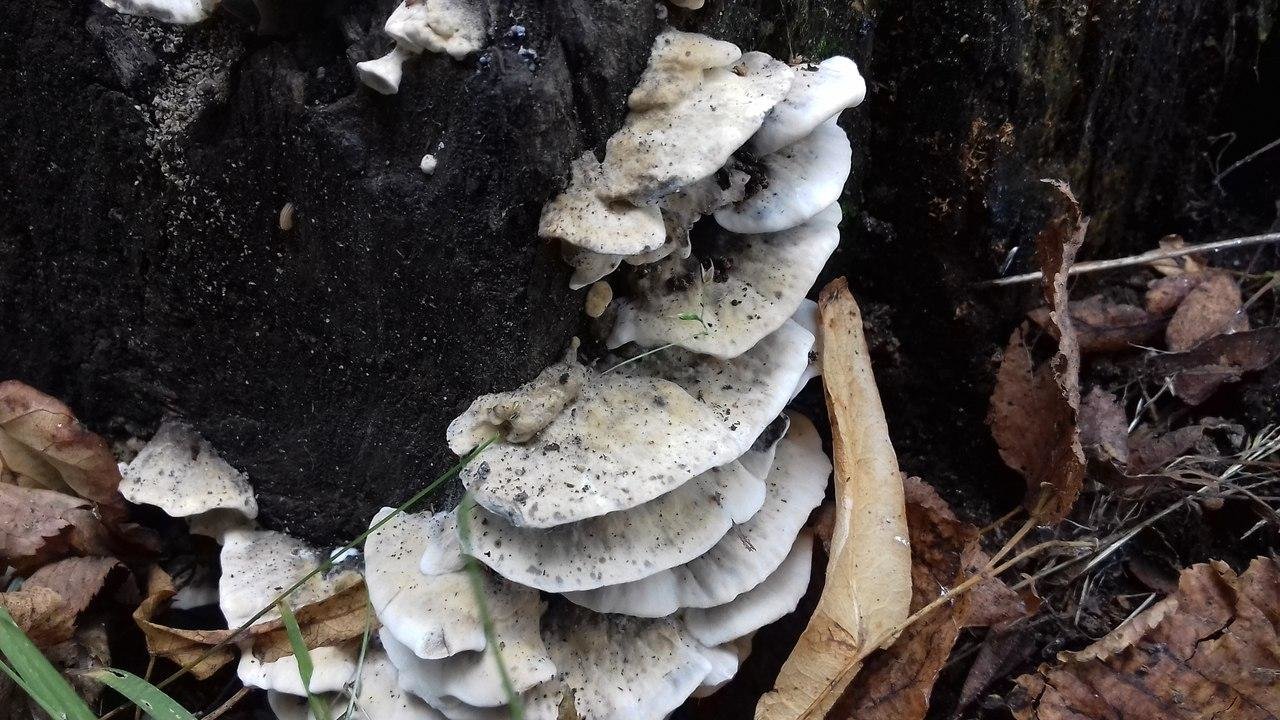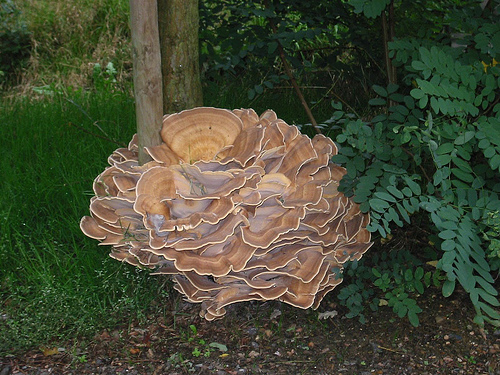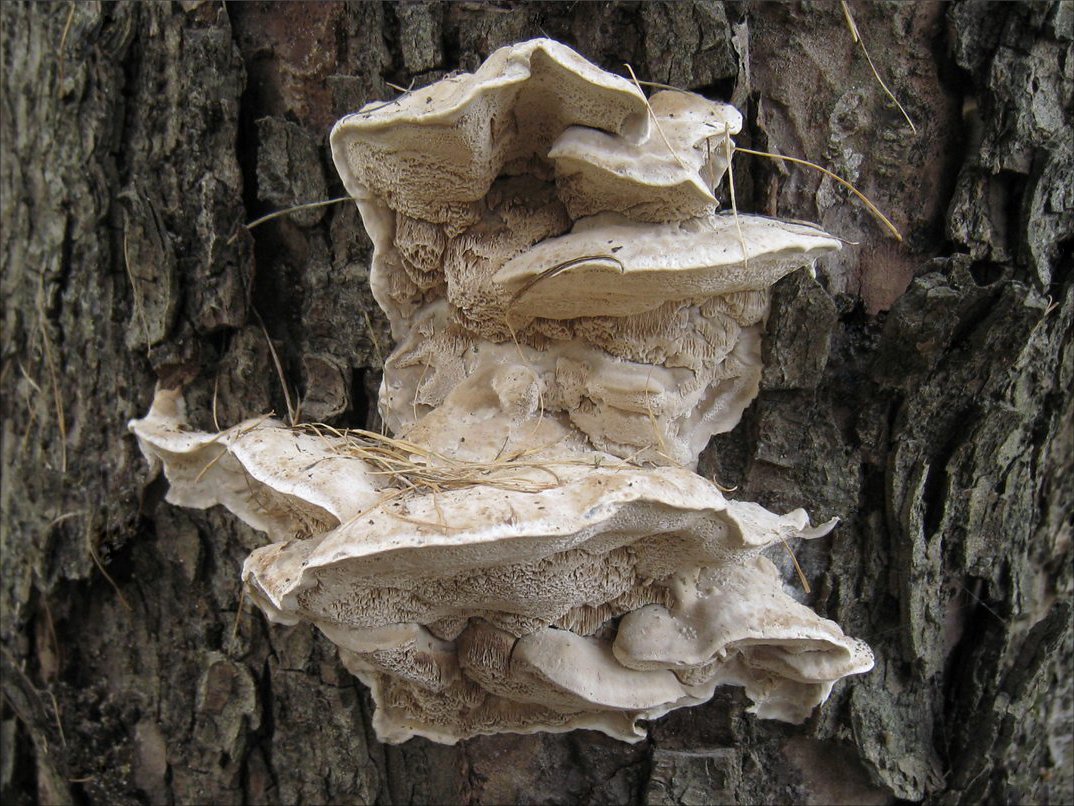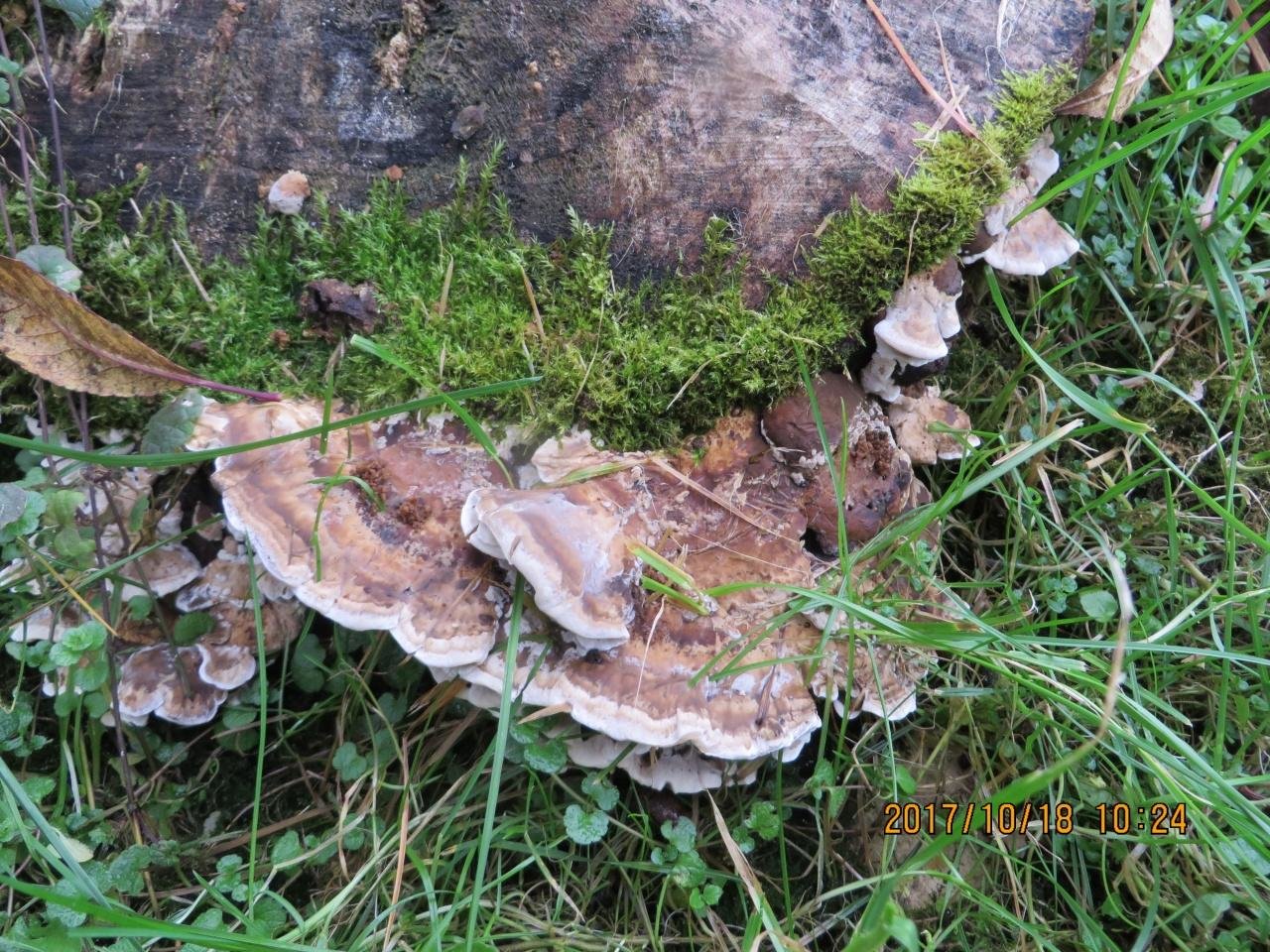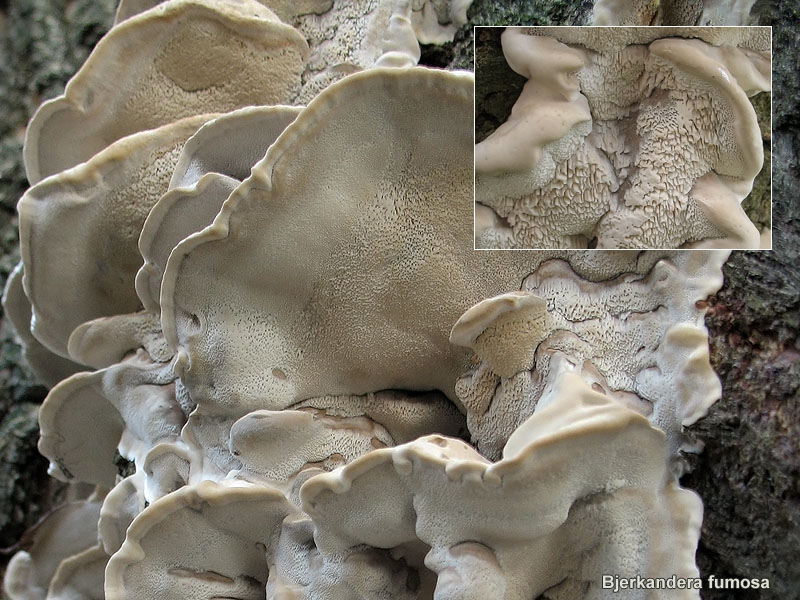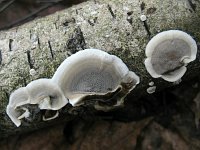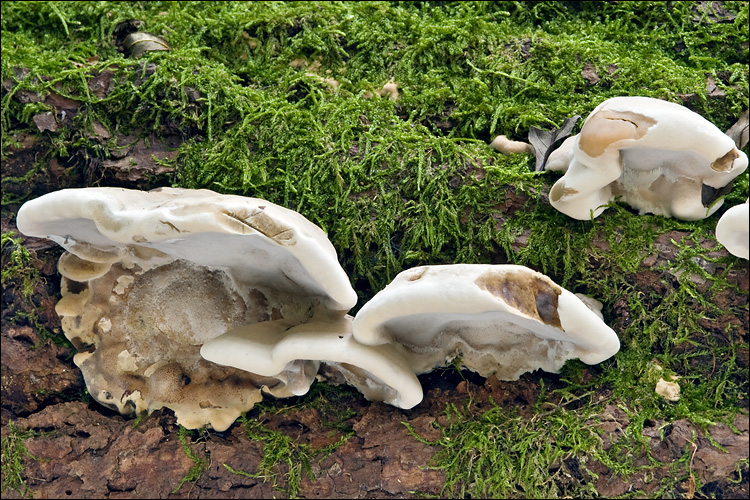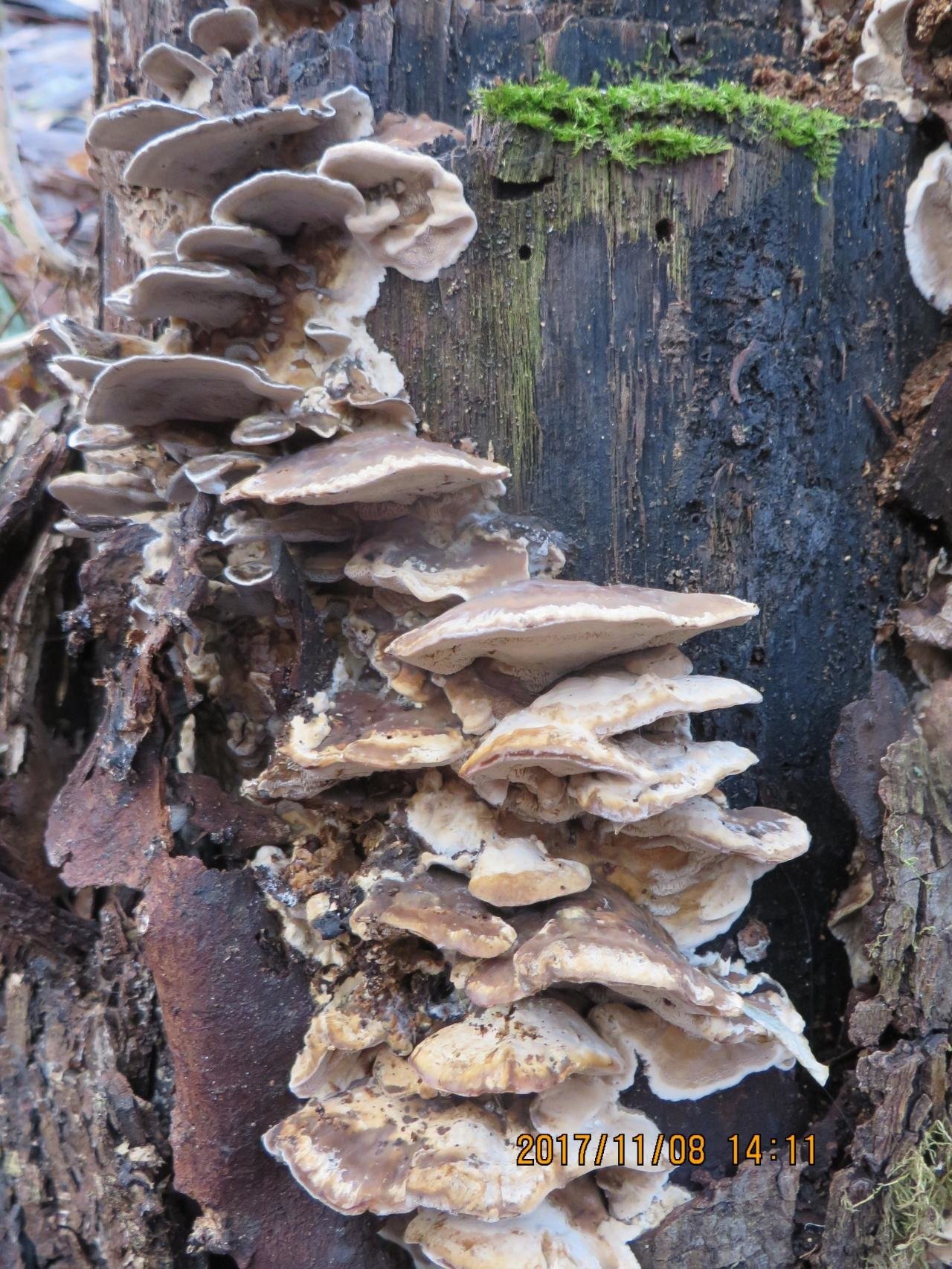Mycelium on cubes Smoky polypore (Bjerkandera smoky), Bjerkandera fumosa
Minimum order - 10 pcs.
Show all wholesale prices

- Payment and delivery terms
- Schedule
- Address and contacts
Smoky polypore (Bjerkandera smoky), Bjerkandera fumosa
Smoky polypore forms annual fruiting bodies, fleshy and relatively large, usually prostrate-bent, tiled or in small aggregates, less often solitary, sessile. The color of the fruit bodies is more or less uniform: at first, isabella-cream, later yellowish, reddish-brownish. The edge is often darker than the surface, sterile, thickish in young specimens, thinning and sharpening with age.
Hats up to 12cm in greatest dimension and up to 2cm thick, even or slightly wavy, without zones or with one or two weakly expressed pale gray-brown zones; the surface is thinly pubescent, bare with age. The tissue is softly fibrous, thick, the color of the cap; a thin dark line is visible on the section of the fruiting body above the layer of tubules. Hymenophore up to 5 mm thick, isabella, whitish-smoky, brownish-cream in old age, with uneven pores, often has a characteristic columnar structure. The pores are 2-5 by 1 mm, rounded or oblong, sometimes slightly sinuous, with solid, sometimes jagged edges.
The hyphalous system is pseudodimitic. Generative hyphae 2.5-3.5 µm in diameter, pseudoskeletal hyphae 3-7 µm in diameter, branching at an acute angle. Spores are ellipsoidal-cylindrical to almost fusiform, 5.5-7x2.5-3.5 μm.
It grows from spring to late autumn on living trees, dry trunks and stumps of deciduous trees, especially often found on willow and ash, as well as on an apple tree. It differs from the related tinder fungus, the singed Bjerkandera adusta, in a more even yellowish-creamy, yellowish-brownish coloration of the surface of the cap and hymenophore, and somewhat larger fruit bodies. The young fruiting bodies of these two species can be very similar.
Harvested and grown for medical purposes.
Description of lacquered tinder fungus
The diameter of the lacquered tinder fungus cap is on average 8-20 centimeters. The shape of the cap is ovoid; its structure is very strong, woody. The hat is covered with a shiny, smooth skin. It is wavy, uneven, divided into numerous concentric rings of different shades. The color of the cap varies from reddish to violet-brown, sometimes it can be black with a yellowish tinge, while the growth rings stand out well.

The height of the leg of the Reishi mushroom ranges from 5 to 25 centimeters, and its diameter is 1-3 centimeters. The leg is long, cylindrical, uneven, growing laterally. The leg is very dense in structure. The tubes are short ocher in color.
The pulp of lacquered tinder fungus is very tough, ocher color. The pulp has no taste or smell. At first, the structure of the pulp is spongy, but over time it stiffens. The pores are round and small, at first they are whitish, but then they turn yellow and brown. Spore powder, brown color.
Spread of lacquered tinder fungus
Lacquered polypores grow in almost all countries of the world. These are saprophytic mushrooms - wood destroyers, as a result of which white rot is formed on trees. They settle on weakened or dying deciduous trees, very rarely found on conifers. Occasionally, these fungi can be found on living trees, but most often they are found on stumps, at the very base, near the soil surface. Sometimes varnished polypores can be found directly in the soil. These mushrooms bear fruit from July to late autumn.

Cultivation of varnished tinder fungus
In Russia, varnished tinder fungi grow mainly in the southern regions - in the North Caucasus, in the Krasnodar and Stavropol Territories.They are more common in the subtropics, and in temperate latitudes they are much less common.
Cultivation of varnished tinder fungus
Reisha mushrooms are highly valued in the countries of Southeast Asia, and they are also cultivated there. Today, these mushrooms are successfully grown in Japan, China and Vietnam.
Varnished polypores are quite easy to grow at home. A stump of a tree with mushrooms is kept in a dark place, at a temperature of 18-25 degrees and a humidity of 75%. The moisture content of the soil should be checked daily, as the mushrooms do not tolerate drying out or waterlogging.

Smoky polypore (Bjerkandera smoky, Bjerkanderafumosa) how it looks, where and how it grows,
Bjorkandera smoky (Smoky polypore): photo and description, impact on trees
| Name: | Smoky polypore |
| Latin name: | Bjerkandera fumosa |
| View: | Inedible |
| Synonyms: | Bjorkandera is smoky. |
| Specifications: | |
| Systematics: |
|
Smoky tinder fungus is a representative of tinder species, wood destroyers. It settles on the stumps of dead trees, almost immediately after that, the remnants of vegetation turn into dust. In various sources, you can find other names for it: bjerkandera smoky, Latin - Bjerkandera fumosa.
Description of the smoky tinder fungus
The hat grows up to 12 cm in circumference, up to 2 cm thick, its color is pale gray, while the edges are very light than the center. The surface is smooth or finely hairy.
The shape of the fungus is effusive-reflex, stretched over the substrate, in the form of a cap attached to the trunk, or extended, curved. The leg is missing.
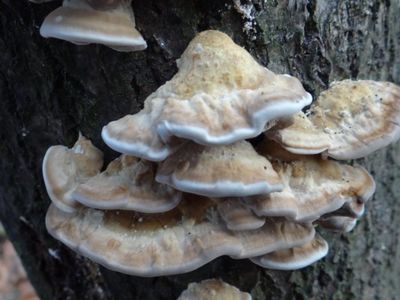
There may be several mushroom caps on a tree, over time they grow together into one total mass
Ripe smoky polypores turn yellow. The edges of the cap are rounded, becoming sharper as they grow. The young representative of the species is friable, light gray, becomes compacted and brown with age.
A characteristic feature of a mature specimen: when cut on the fruiting body, a thin, dark line can be seen above the layer of tubules. The flesh of the mushroom is thinned, dark brown in color, spongy and tough.
With the arrival of the fruiting period, the bjorkander produces white, beige or colorless pores. They are located on the other side of the fruiting body, have a rounded, spherical shape, over time they become angular. On 1 mm of the surface of the fungus, from 2 to 5 smooth, very small spores mature. Their powder is straw yellow.
Where and how it grows
A parasitic fungus grows on fallen forest and garden trees, decaying stumps of deciduous crops. For gardeners, the appearance of a bjorkandera is a signal of the unhealthy of a fruit-bearing tree. It is necessary to immediately take measures to destroy the parasite, since the entire area will soon undergo infection.
In spring, the fungus parasitizes living trees, without signs of wilting.
Fruiting begins in April and lasts until the end of autumn (November). The smoky polypore feeds on the decaying remains of wood. The parasitic fungus is widespread in the Northern Hemisphere, everywhere in Russia, not counting the southern regions.
How does smoky tinder fungus affect trees
Mycelium spores enter the bark of the tree through cracks and breaks. Bjorkander, settling on the bark, grows in the center of the trunk, destroying it inside, embodies it in dust. At its first appearance, measures are taken, very often cardinal - the tree is destroyed, since it is impossible to remove the mycelium under the bark. Also, all smoky stumps affected by spores are uprooted. It is impossible to allow the spread of bjorkandera: it produces new, young fruiting bodies in a short time.
Doubles and their differences
The tinder fungus of this species has an inedible twin - the scorched bjorkander.The mushroom is spread everywhere, not only in our country, but all over the world. Fruiting from May to November.
The contrasting color distinguishes this basidiomycete from the rest of the species.
The mushroom cap has a shape similar to smoky tinder fungus - semicircular, outstretched, but thicker flesh. The tubes are also very large and brownish.
The skin on the cap is velvety, finely hairy. The color of the singed bjorkander is darker than that of the tinder fungus, actually black or dark gray, the edges have a whitish edging.
The places and region of residence of the two species are similar.
Conclusion
Smoky polypore is a basidiomycete parasitizing on deciduous trees. Its occurrence provokes the development of white mold - a disease dangerous for horticultural crops. The fight against the fungus at the first sign of its appearance should begin without delay. The key method is the uprooting and removal of infected debris from the site.
Scorched Bjerkandera, Bjerkandera adusta
Fruit body: An annual "tinder fungus", whose appearance changes radically in the process of development. Begins Bjerkandera adusta as a white drip on a dead wood, stump, or dry; very soon the middle of the formation darkens, the edges begin to bend back, and the drip formation turns into rather shapeless, often fused together consoles of leathery “caps” 2-5 cm wide and about 0.5 cm thick. The surface is pubescent, tomentose. The coloration also changes significantly over time; the white edges give way to the general gray-brown scale, which makes the mushroom really look like “scorched”. The flesh is greyish, leathery, tough; with age it becomes “corky” and very brittle.
Hymenophore: Thin, with very fine pores; separated from the sterile part by a thin "line" visible to the armed eye when cut. In young specimens, it has an ash color, then gradually darkens almost to black.
Spore powder: Whitish.
Spreading: It is ubiquitous throughout the year, preferring dead deciduous wood. Causes white rot.
Similar species: The age-related variability of the fungus makes it extremely difficult to distinguish Bjerkandera adusta from many other polypores with open fruiting bodies; for a confident determination, one should rely on the whole complex of signs. Alexandra Arzhenenko, a mycology student from St. Petersburg State University, points to a closely related species - the smoky bjerkandera, Bjerkandera fumosa, which is no less common in our area than the scorched bjerkandera. It differs, in addition to larger disputes, in a peculiar shade of gray: closer to coffee.
Author's notes: This scorched bjorkandera is one of those mushrooms that are actually known to everyone and everyone, and for a nominal acquaintance, you need to ask for help on the forum, then leaf through a huge book about tinder fungus, published in 1953, rescued by someone from the conflagration of the Voronezh library. But everything, of course, ends well.
It is very similar to a mushroom house - the hymenophore is sticking out. Bjerkandera adusta in youth and maturity are two different mushrooms. This one is young. He grew up on a stick propping up a lilac. I took him for a crying sickle who came out for a walk, but life has proved the opposite.

